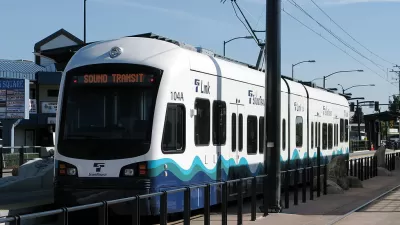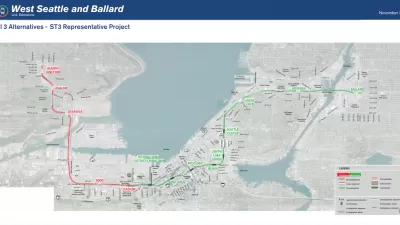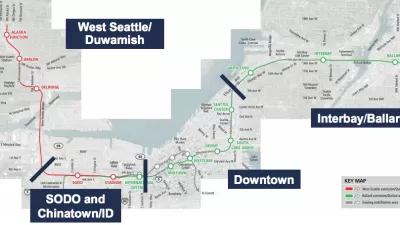Sound Transit is moving forward with a proposed route despite severe cost overruns, throwing other major rail projects into question.

Sound Transit revealed higher-than-expected projected cost overruns for the West Seattle Link Extension project, reports Ryan Packer in The Urbanist, but the Sound Transit board indicated it would continue to support the project without considering alternative options. The project is now estimated to cost as much as $7.1 billion, close to $3 billion more than initial projections.
According to Packer, “Even as the agency touts internal reforms that it says could bring some of these cost increases down to more manageable levels and help Sound Transit regain some ground, there are storm clouds brewing when it comes to the affordability of the entire Sound Transit 3 program.”
Packer outlines other potential options that could save the agency money, such as the Elevated Fauntleroy Way alternative, which could reduce costs by as much as $850 million. But according to Sound Transit CEO Goran Sparrman, “The reality is that the kind of cost escalation we’re seeing on the preferred alignment, that is a largely [sic] driven by broader market forces, so I don’t know that we would expect to see significant lower cost in any other alternatives.”
For Packer, the cost increases pose a broader question about the future of the ST3 program and the Ballard Link project, a ‘sister project’ to the West Seattle extension that could cost $11.2 billion.
FULL STORY: Sound Transit Board Forges Ahead on West Seattle Link Despite Cost Jumps

Maui's Vacation Rental Debate Turns Ugly
Verbal attacks, misinformation campaigns and fistfights plague a high-stakes debate to convert thousands of vacation rentals into long-term housing.

Planetizen Federal Action Tracker
A weekly monitor of how Trump’s orders and actions are impacting planners and planning in America.

In Urban Planning, AI Prompting Could be the New Design Thinking
Creativity has long been key to great urban design. What if we see AI as our new creative partner?

Pedestrian Deaths Drop, Remain Twice as High as in 2009
Fatalities declined by 4 percent in 2024, but the U.S. is still nowhere close to ‘Vision Zero.’

King County Supportive Housing Program Offers Hope for Unhoused Residents
The county is taking a ‘Housing First’ approach that prioritizes getting people into housing, then offering wraparound supportive services.

Researchers Use AI to Get Clearer Picture of US Housing
Analysts are using artificial intelligence to supercharge their research by allowing them to comb through data faster. Though these AI tools can be error prone, they save time and housing researchers are optimistic about the future.
Urban Design for Planners 1: Software Tools
This six-course series explores essential urban design concepts using open source software and equips planners with the tools they need to participate fully in the urban design process.
Planning for Universal Design
Learn the tools for implementing Universal Design in planning regulations.
planning NEXT
Appalachian Highlands Housing Partners
Mpact (founded as Rail~Volution)
City of Camden Redevelopment Agency
City of Astoria
City of Portland
City of Laramie





























